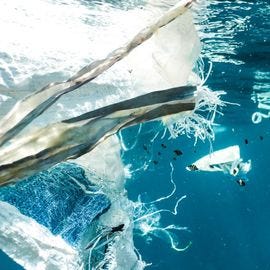Fashion takes a stand against microplastic pollution

In the midst of Plastic Free July, a global campaign to end plastic waste, the fashion industry stepped up to address the growing problem of microplastic pollution stemming from synthetic fabrics.
The hidden threat
While microplastics are widely recognized as an environmental menace, many are unaware of their connection to the fashion industry. Petroleum-based fabrics like polyester, nylon, and acrylic shed tiny microfibers during washing, which end up polluting oceans, waterways, and even the air we breathe. These microfibers can enter the food chain and pose serious health risks.
As per CFDA data 342 million barrels of oil are used annually to produce plastic-based fibers for textiles. Nearly 70 per cent of materials in fashion textiles are synthetic fibers, says the Changing Markets Foundation. And 35 per cent of microplastics in the ocean come from washing synthetic clothing. Up to 700,000 microplastic particles can be released from synthetic apparel in a single wash highlights Fashion Revolution.
Cotton, the natural solution
The fashion industry is realizing the power of natural fibers like cotton in combating microplastic pollution. Cotton, a cellulose-based fiber, biodegrades readily, unlike synthetic fibers that can persist for centuries.
"Cotton biodegrades in a relatively quick time... Biodegradability of apparel is crucial for reducing waste," says Jesse Daystar, of Cotton Incorporated.
Almost 76 per cent consumers want clothing made from biodegradable materials reveals Cotton Incorporated latest study done with Lifestyle Monitor.
Brands embracing change
With growing demand among consumers for sustainable fibers brands are adopting natural fibers. Andine, a Los Angeles-based loungewear brand, prioritizes natural fibers like cotton. "Andine strives for quality goods made from natural fibers... We prefer fabrics that are as soft as butter and made 100 per cent out of cotton," says Elisabeth Weinstock, Andine's Founder.
In fact, the Cotton Inc study shows 65 per cent consumers check fiber content labels to avoid synthetic fibers. Nearly 3 in 10 shoppers are bothered by the use of synthetic fibers in clothing.
Consumer awareness on the rise
Almost 45 per cent consumers are aware of clothing microfibers polluting oceans and waterways, a significant increase from 27 per cent in 2018 reveals the Cotton Inc study.
To meet growing demand for sustainable fibers innovations are leading the way. For example, Cotton Inc's Fabricast library showcases innovative cotton fabrics and technologies, offering designers inspiration for sustainable and high-performance garments. "Cotton fabrics can be engineered with... technologies that move moisture away from the body," says Yvonne Johnson, Cotton Inc.
During Plastic Free July, brands urged to consider the environmental impact of their choices. Almost 37 per cen consumers prioritize sustainability when choosing brands Monitor research showed. And 81 per cent consumers believe better quality garments are made from all-natural fibers.
The shift towards natural fibers like cotton signals a positive change in the fashion industry. As consumers become increasingly aware of the environmental consequences of their choices, brands that prioritize sustainability and quality will lead the way towards a cleaner, greener future.
